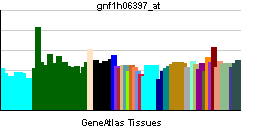HOXC9
| Homeobox C9 | |||||||||||
|---|---|---|---|---|---|---|---|---|---|---|---|
| Identifiers | |||||||||||
| Symbols | HOXC9 ; HOX3; HOX3B | ||||||||||
| External IDs | Template:OMIM5 | ||||||||||
| |||||||||||
| RNA expression pattern | |||||||||||
 | |||||||||||
| More reference expression data | |||||||||||
| Orthologs | |||||||||||
| Template:GNF Ortholog box | |||||||||||
| Species | Human | Mouse | |||||||||
| Entrez | n/a | n/a | |||||||||
| Ensembl | n/a | n/a | |||||||||
| UniProt | n/a | n/a | |||||||||
| RefSeq (mRNA) | n/a | n/a | |||||||||
| RefSeq (protein) | n/a | n/a | |||||||||
| Location (UCSC) | n/a | n/a | |||||||||
| PubMed search | n/a | n/a | |||||||||
Homeobox C9, also known as HOXC9, is a human gene.[1]
This gene belongs to the homeobox family of genes. The homeobox genes encode a highly conserved family of transcription factors that play an important role in morphogenesis in all multicellular organisms. Mammals possess four similar homeobox gene clusters, HOXA, HOXB, HOXC and HOXD, which are located on different chromosomes and consist of 9 to 11 genes arranged in tandem. This gene is one of several homeobox HOXC genes located in a cluster on chromosome 12.[1]
See also
References
Further reading
- McAlpine PJ, Shows TB (1990). "Nomenclature for human homeobox genes". Genomics. 7 (3): 460. PMID 1973146.
- Acampora D, D'Esposito M, Faiella A; et al. (1990). "The human HOX gene family". Nucleic Acids Res. 17 (24): 10385–402. PMID 2574852.
- Boncinelli E, Acampora D, Pannese M; et al. (1990). "Organization of human class I homeobox genes". Genome. 31 (2): 745–56. PMID 2576652.
- Rabin M, Ferguson-Smith A, Hart CP, Ruddle FH (1987). "Cognate homeo-box loci mapped on homologous human and mouse chromosomes". Proc. Natl. Acad. Sci. U.S.A. 83 (23): 9104–8. PMID 2878432.
- Redline RW, Hudock P, MacFee M, Patterson P (1994). "Expression of AbdB-type homeobox genes in human tumors". Lab. Invest. 71 (5): 663–70. PMID 7967520.
- Miano JM, Firulli AB, Olson EN; et al. (1996). "Restricted expression of homeobox genes distinguishes fetal from adult human smooth muscle cells". Proc. Natl. Acad. Sci. U.S.A. 93 (2): 900–5. PMID 8570656.
- Apiou F, Flagiello D, Cillo C; et al. (1996). "Fine mapping of human HOX gene clusters". Cytogenet. Cell Genet. 73 (1–2): 114–5. PMID 8646877.
- Flagiello D, Gibaud A, Dutrillaux B; et al. (1997). "Distinct patterns of all-trans retinoic acid dependent expression of HOXB and HOXC homeogenes in human embryonal and small-cell lung carcinoma cell lines". FEBS Lett. 415 (3): 263–7. PMID 9357979.
- Kosaki K, Kosaki R, Suzuki T; et al. (2002). "Complete mutation analysis panel of the 39 human HOX genes". Teratology. 65 (2): 50–62. doi:10.1002/tera.10009. PMID 11857506.
- Strausberg RL, Feingold EA, Grouse LH; et al. (2003). "Generation and initial analysis of more than 15,000 full-length human and mouse cDNA sequences". Proc. Natl. Acad. Sci. U.S.A. 99 (26): 16899–903. doi:10.1073/pnas.242603899. PMID 12477932.
- Ota T, Suzuki Y, Nishikawa T; et al. (2004). "Complete sequencing and characterization of 21,243 full-length human cDNAs". Nat. Genet. 36 (1): 40–5. doi:10.1038/ng1285. PMID 14702039.
- Luo L, Yang X, Takihara Y; et al. (2004). "The cell-cycle regulator geminin inhibits Hox function through direct and polycomb-mediated interactions". Nature. 427 (6976): 749–53. doi:10.1038/nature02305. PMID 14973489.
- Gerhard DS, Wagner L, Feingold EA; et al. (2004). "The status, quality, and expansion of the NIH full-length cDNA project: the Mammalian Gene Collection (MGC)". Genome Res. 14 (10B): 2121–7. doi:10.1101/gr.2596504. PMID 15489334.
- Okamoto OK, Oba-Shinjo SM, Lopes L, Nagahashi Marie SK (2007). "Expression of HOXC9 and E2F2 are up-regulated in CD133(+) cells isolated from human astrocytomas and associate with transformation of human astrocytes". Biochim. Biophys. Acta. 1769 (7–8): 437–42. doi:10.1016/j.bbaexp.2007.05.002. PMID 17588684.
External links
- HOXC9+protein,+human at the US National Library of Medicine Medical Subject Headings (MeSH)
This article incorporates text from the United States National Library of Medicine, which is in the public domain.
| This protein-related article is a stub. You can help Wikipedia by expanding it. |